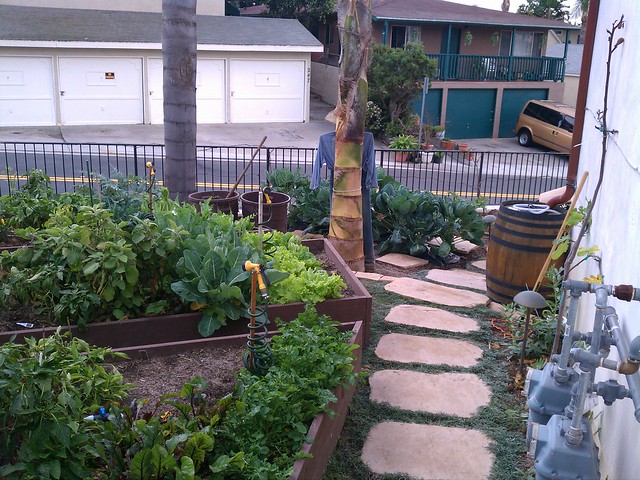The math on rain water harvesting is very important if people are to embrace this technology. People assume that there is not enough rain in Southern California to warrant investment in the harvesting of rain water. Allow me to demonstrate that this thinking is wrong.
Please consider;
1000 square feet of roof yield 623 gallons of water per inch of rain.
The whole calculation goes like this; Roof area (ft square) X rainfall ( ft ) X 7.48 gal/ft+ total rainwater ( gal ).
For example, if you want to calculate how much rainwater in gallons falls on your 55-by-80-foot ( 4400-square-foot) lot in a normal year where rain fall averages 12 inches. the calculation would look like this;
4,400-square-foot catchment area X 1 foot of average rainfall X 7.48 gallons per cubic foot = 32,912 gallons of rain falling on the site in an average year rain.
Credit on the above
data.
So one of the key concepts is to live within your site's water budget.
That means
using your properties annual average rainfall as the basis of what plants get used in your yard. Excess water collected from the roof is then used ( in theory ) to water the plants that require more than the natural rainfall ( such as fruit trees and vegetable gardens ) so that for the ornamental landscaping no further use of city water is required to have a lush and attractive yard.
Consume less water on your property than falls on your property in an average year of rainfall.
 |
| Rain water helps powers this food garden in San Clemente Califonia. | | | | | |
|
|
Currently some cities offer rebates towards the implementation of rain water systems. You can help facilitate this by contacting your representative and letting them know your town wants those rebates too! Solar is far more expensive and out of reach for many into today's harsh Southern California economy.
Please consider the following;
- Rainwater ( and hail, sleet and snowfall ) is delivered to us free of charge, eliminating the need for costly distribution systems. Did you know that 20% of all energy consumed in California is used to transport, treat or store water?
- Rainwater is the highest-quality source of irrigation water
- Rain water is salt-free and can help flush plant damaging salts from the root zone in alkaline soils
- Rainwater is a natural fertilizer containing sulfur, beneficial microorganisms, mineral nutrients, and nitrogen
- Rainwater harvesting helps reduce utility bills
- Rainwater harvesting reduces flooding by reducing flow to streets and storm drains
- Rainwater harvesting reduces nonpoint-source pollution of stormwater
- Rainwater harvesting provides a water source when well, surface, or municipal water is contaminated or unreliable ( such as after a major Earthquake )
- Water harvesting helps utilitys reduce summer peak demands for water and reduces the volume of wastewater that needs to be treated at water treatment plants
- Water harvesting is fun! The food from my garden tastes better than store bought food and we have emergency water storage
 |
| This is our own family rain garden. This year we produced onions, potatoes, strawberries, rosemarry, mint, thyme, basil, oregeno, sage, carrots and more. We just planted peppers and tomatoes for the summer growing season. |
Using a three thousand square foot home in Yorba Linda California as a model we conclude that if that home harvested just one third the home into a rain tank or cistern system they would have
8,700 gallons yield per year. These are facts. Here is a link to the rainfall data;
click here. That is 23.83 gallon of fresh water available for use
every single day.
That is why larger systems make sense.
More from our own raised flower beds this year;
 |
| lettuce and oregeno |
 |
| Potatoes ( foreground ) mint and green onions |
 |
Tomatoes and fresh basil from the garden with mozzarella cheese ( yummy! )
|
 Facebook
Facebook
 X
X
 Instagram
Instagram
 TikTok
TikTok
 Youtube
Youtube









